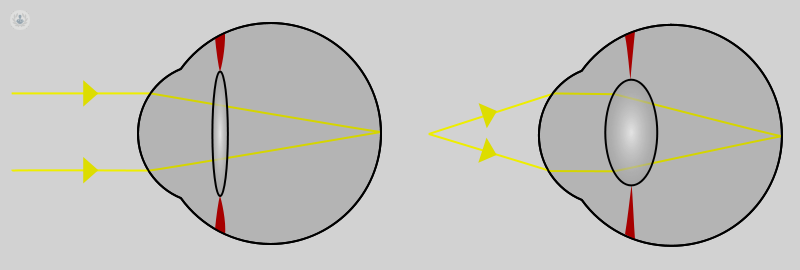Meet the presbyopia, common pathology from 40
Written by:The presbyopia is the loss of lens accommodation by an aging process, which appears after 40 years. In this way loses ability to focus on close objects. Treatment: glasses or surgery with intraocular lenses.
Presbyopia: what is
The presbyopia is the loss of lens accommodation as a result of a natural process of aging. The lens is a dynamic and elastic lens having the ability to modify its power to focus on objects at all distances.

In figure two eyeballs are shown with different crystal size. In the right image, the lens is too convex (round) to increase its power and to focus near vision, to read, for example. The image on the left shows a thin lens, when the patient is looking into the distance.
When and why it appears eyestrain
From age 40 lose the ability to focus on close objects. It is a consequence of natural aging. Just as the collagen fibers of the skin lose elasticity and we get wrinkles as we age, so it does to change its shape and able to focus on objects close to the elasticity of the lens. The entire population suffers from a certain age and can not be prevented.
Symptoms and Diagnosis of Presbyopia
Diagnosis is clinical. The patient experiences a progressive difficulty seeing up close due to age. When it begins, the patient complains of difficulty reading in low light, need to separate the arms and distance support in paper or electronic screen you are reading. Finely an impossibility given for activities closely as reading, sewing, reading mobile, among others.
Treatment of Presbyopia
The option of immediate treatment are glasses. The surgical treatment of presbyopia must be performed by an expert in ophthalmology and should be completely individualized and depends on the needs of each patient and the initial refractive presented. But for those patients who are uncomfortable glasses or do not want to take for aesthetic reasons can interpose. In early stages of presbyopia may be improved by acting on the cornea. In more advanced stages we use microsurgery (for incisions 2 mm), aged removing the lens and replacing it with an intraocular lens premium, next-generation: bifocals or trifocals. These multifocal lenses have concentric circles that allow you to see the patient focusing at all distances.The following images show different multifocal intraocular lenses that replace the aged crystalline and allow us to see at all distances without using glasses in most of our daily activities is.




